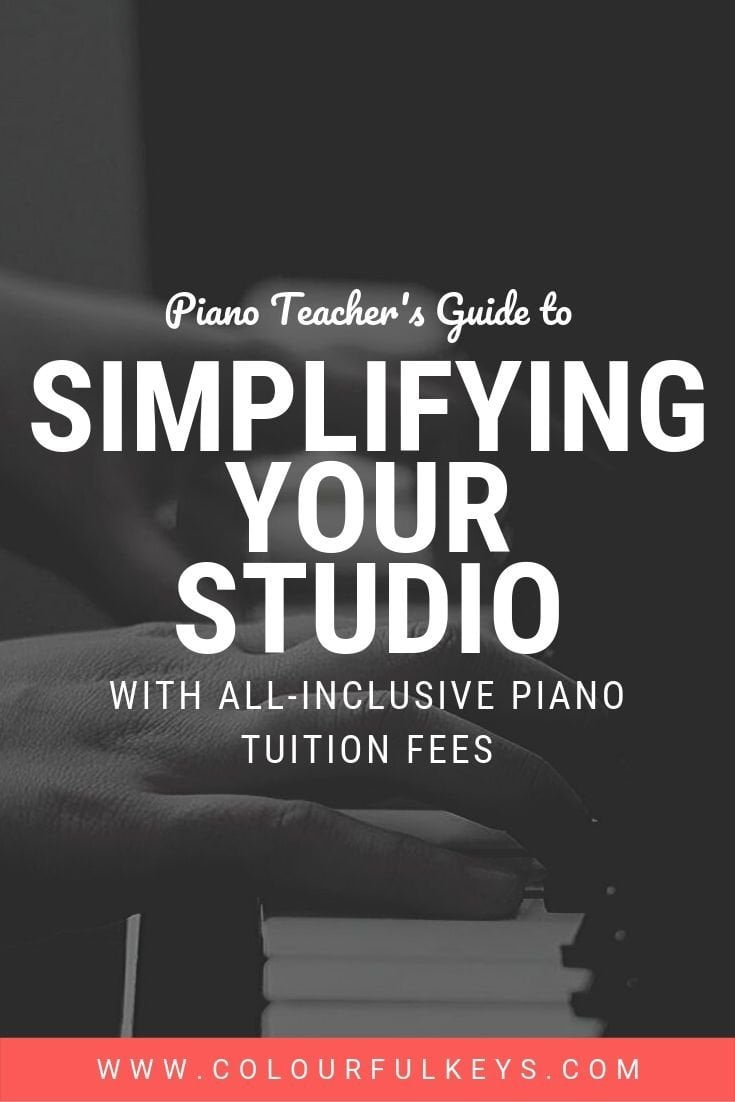There’s a lot of chatter in piano teaching communities about the various tuition structures. But have you ever considered an all-inclusive piano tuition fee structure?

Making your tuition all-inclusive (whether you choose monthly or term-based payments) can make it easier to plan and budget for both you and your piano parents. It can also help you to change your piano parents’ make-up lesson mindset.
But what does it even mean? What’s included in all-inclusive fees?
What is an all-inclusive piano tuition fee structure?
When I talk about my studio having “all-inclusive piano tuition fees” what I mean is simply that I never charge extra for anything. Parents pay an annual registration fee and either monthly or semesterly tuition payments and that covers:
- Their regularly scheduled piano lesson (most students are in buddy lessons)
- 4 group workshops per year
- 2 recitals per year
- All books and sheet music
- Access to the lending library of games, kids books about music and sight reading resources
- Practice kits, studio bags and studio t-shirts
- Folders and printed resources
- Home access to Piano Maestro
The only thing I don’t include is exam fees. That’s because only some of my students take exams, and even those who do take them don’t take them every year. So it would be a big expense to factor in for only a few students and wouldn’t be fair to those who don’t do exams.
How do all-inclusive fees benefit the students and parents?
For many parents, it’s a big relief not to have another list of books to go buy. In fact, I can often see this relief wash over their face when I mention this in our first meeting.
It’s also easier for them to budget. They know that no surprises are going to pop up in the middle of the year. The price is the price.

How do all-inclusive fees benefit the teacher?
All-inclusive piano tuition fees can be a huge weight off your shoulders too.
If you include everything in your tuition fees, you don’t need to remember to chase up a book reimbursement or remind parents to buy a new practice notebook. You can set up your invoices at the start of the year knowing that they’re not going to change.
It also means that your students will always have what they need, when they need it. If you’ve ever had a parent purchase the wrong edition of a book you know what I’m talking about. Even worse is that parent who takes 6 weeks to finally get a new level of a book, while you’re left to improvise and scrape a lend in the meantime!
With all-inclusive tuition fees, you’re in control.
I keep a large library of my standard and favourite books on hand in the studio, so all I have to do is grab one off the shelf. I also get to spend some time with new repertoire and play through it before handing it off to a student.
I switched to an all-inclusive system about 6 years ago and I honestly haven’t looked back since. It’s one of the best decisions I’ve made for my studio.
Are you considering switching to an all-inclusive music lesson fee structure?
Tell me what’s holding you back or what pitfalls you foresee in the comments below or in the Vibrant Music Teaching Facebook group. And if you want a wider view of various fee structures, check out the Policies & Payments section of my Studio Business page.

I LOVE being all-inclusive! My students pay tuition quarterly, so I only do bookkeeping four times per year. 🙂
I do something similar but without the books. How do you adjust your price to include books, especially since each student has different needs for books (ex. some would need more throughout the year than others)
I don’t adjust it, I let it average out across all my students.
if everything is included, how do you calculate the monthly fee?
I LOVE this idea! I believe I will switch to this model- I hate charging for books as I go! Thanks!